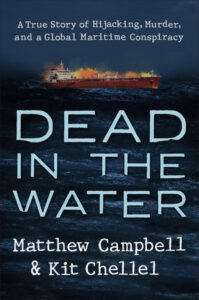A supertanker in trouble is a singular event. It requires the attention of naval fleets, coast guards, international marine agencies, and governments across the immediate region, as well as in the homelands of its crew. That’s not to mention those with a financial interest: the shipowners, cargo owners, bankers, and insurers backing the voyage, and a diffuse crowd of brokers, lawyers, traders, agents, and investors from London to New York, Dubai, and Singapore.
If the Brillante Virtuoso sank to the sandy bottom of the Gulf of Aden, the financial blow would be substantial. Most obviously, a vessel with a nominal value of $55 million would be lost. The $100 million of oil stored in its hull would also have to be recovered in an expensive underwater operation, or else secured to stop it from spilling out and fouling the coastlines of the Gulf with a million barrels of black sludge, the cleanup of which might run into the billions. Equally worrying, if the events on the Brillante signaled a new tactic—if Somali pirates were willing to blow up ships traveling along one of the world’s busiest maritime highways—that was the kind of problem global leaders would need to address.
At 3:06 a.m., three minutes after the Brillante crew made radio contact with the USS Philippine Sea, someone on the tanker’s bridge pressed a concealed button, triggering a distress signal. Vessels over a certain size are required by antipiracy regulations to have security systems capable of sending real-time data to shore, enabling a rapid response to an incident. The moment the Brillante’s Ship Security Reporting System (SSRS) was activated, it automatically generated messages that were delivered to various government and private-sector organizations. The alerts included the vessel’s name, position, speed, and status: “MV Brillante Virtuoso, IMO 9014822, Liberian flag at posn 1229N 04445E crse 140, 0.5 kts.”
Within seconds, one such message arrived at the office of United Kingdom Maritime Trade Operations, or UKMTO, in Dubai. To this day, the UK retains an outsize role in marine affairs, a legacy of when the Royal Navy patrolled an empire on which the sun never set. Even as Britain’s influence waned after the Second World War, much of the legal and administrative machinery of modern shipping remained in British hands. In the 2000s, with piracy escalating into a severe problem, the UKMTO was made responsible for connecting military forces with the merchant ships they were supposed to protect, keeping everyone communicating during a crisis.
Petty Officer Bob Boosey got a call summoning him to the UKMTO operations room just after 3:00 a.m. “We’ve got an incident,” the official on watch told him. Boosey, a Royal Navy lifer, lived in an outbuilding within the pale walls of the British Embassy compound in Dubai’s diplomatic district. It was a short walk, and he hustled over without stopping to change into his white uniform. Boosey was surprised to be called in the dead of night. In his years tracking piracy, he’d never known Somali raiders to attack after dark, when boarding a ship was far more challenging. But he had little time to dwell on the thought.
Inside the dimly lit operations room, about a dozen computer screens relayed nautical data, including three large wall monitors showing UKMTO’s zone of responsibility: roughly four million square miles of ocean, stretching from the mouth of the Suez Canal down to Kenya and eastward to the Indian coast. The pirate-infested High Risk Area was outlined in red, with the Brillante Virtuoso displayed as a dot squarely inside the danger zone. Pinned against another wall were printed images of other ships that had fallen victim to piracy that week, a reminder of the importance of Boosey’s mission.
Boosey had dealt with numerous hijackings in his career, including the 2009 Maersk Alabama incident that inspired Captain Phillips. UKMTO personnel were amused to see their portrayal in the film, which depicted a smartly dressed young cadet communicating with the eponymous captain from what looked like a space-age communications hub. “Chances are it’s just fishermen,” the UKMTO cadet said in the scene. “They’re not here to fish,” replied Phillips.
In fact, back in 2009 the agency had operated from less impressive premises: a converted apartment in a Dubai tower block. Staff would come to work in shorts and T-shirts, so as not to alert the other residents to what was happening inside. They moved to the safety of the British Embassy after being warned that the criminal gangs behind Somali piracy were operating in
Dubai and might consider the UKMTO enough of a nuisance to pay a visit.
After sitting down at his workstation, Boosey began to coordinate with all the naval forces in the region, including US and British installations in Bahrain and allied vessels deployed around the Middle East. Officers were firing questions at him through Mercury Chat, a shared military messaging system. Boosey zoomed in on the Brillante’s icon on his wall monitor to bring up its profile. “TO ALL: BRILLIANTE VIRTUOSO, flag Liberian, owner Marshall Islands, crew 26 all Filipino,” he wrote in a Mercury message at 3:55 a.m. That one transmission encapsulated a set of challenges typical of the fragmented nature of modern shipping. The tanker was owned by a corporate entity in a Pacific tax haven—the Marshall Islands—which was in turn owned by a Greek family based in Piraeus, just outside Athens. It sailed under the flag of tiny Liberia, which augments its finances by selling cheap, hassle-free registrations to about one in ten of the world’s commercial vessels. Not that its regulators actually resided in that impoverished West African nation; by historical quirk, the Liberian registry was run by Israeli-American entrepreneurs operating out of a headquarters in Dulles, Virginia. Meanwhile, the oil the tanker was carrying was owned by a trading firm based in Switzerland and Monaco.
The Brillante’s patchwork of relationships wasn’t unusually complicated by industry standards. It was the by-product of a system that had evolved over the previous six decades to eliminate financial and regulatory friction at every opportunity, driving the price of transporting goods as low as possible.
Operating with minimally paid crews and subject to almost no meaningful taxation, by the early years of the twenty-first century giant cargo ships had become so efficient that it cost only about $2,000 to get a container of gadgets from Shenzhen to one of the dozen or so major US ports. For better and worse, this remarkable fact had transformed the lives of hundreds of millions of people—from European and American consumers, who gained access to unimagined bounties of cheap stuff, to workers in countries like China and Vietnam, given a ticket into the middle class by newly profitable export industries.
Yet the intricacies of this process are hidden from the people who benefit from it, and sometimes even from those charged with policing the oceans. It’s standard practice for vessels to be legally owned by brass-plate companies set up in far-flung tax shelters, of which the Marshall Islands is one of many. Even maritime insiders often find it difficult to determine who a ship actually belongs to, behind whatever entity, usually with a meaninglessly generic name, is listed on an official document. This lack of transparency allows for substantial cost cutting, for example by placing vessels’ earnings far beyond the reach of major tax authorities—as well as regulatory evasion. In the offshore legal netherworld that tankers and container ships inhabit, responsibility for things like safety and crew welfare can be passed around in an endless shell game.
For one thing, the location where a vessel is owned often bears no relation to the country where it’s officially registered, or “flagged.” Technically, the applicable law on any ship is determined by the ensign flying on its deck. In the early twentieth century, most shipowners paid to register under the jurisdiction of major marine powers like Britain and the United States, benefiting from their legal regimes and military protection. But eventually, entrepreneurial officials in countries like Panama realized they could raise revenue by offering what’s now called a flag of convenience. By registering their vessels in these places, owners could avoid developed-world rules on wages, working hours, and union membership, while also being subject to fewer inspections and a more relaxed attitude to regulation.
The practice got a running start during Prohibition, when American cruise liners were able to serve booze to passengers by flagging themselves as Panamanian, and became increasingly common after the Second World War. Today, Panama, the Marshall Islands, and Liberia serve as the ostensible homes of more than a third of the global merchant fleet, and there are even flags of convenience available from places like Mongolia and Bolivia, land-locked countries with no actual maritime industries to speak of. As one chronicler put it, flags of convenience represent “free enterprise at its freest,” with governments competing to provide shipowners with the most laissez-faire environments in which to domicile their assets.
In the UKMTO office in Dubai, it fell to Bob Boosey to untangle this knot of ownership and responsibility in order to get the approvals required to rescue the Brillante’s crew and secure the vessel, hopefully before it ended up on the seafloor. Boosey contacted people in London, the Marshall Islands, Liberia—via its registry headquarters in Virginia—and the Philippines. He was also communicating with a Greek firm called Central Mare, which the Brillante’s owners had hired to operate the tanker day-to-day, making sure it was fully crewed, supplied, and documented.
At approximately 6:00 a.m. Dubai time, a Central Mare employee whom Boosey had tracked down hurried to the firm’s office in Athens and emailed over a crew list, allowing Boosey to check that all personnel were accounted for. Boosey replied with a situation update, passing on that the Brillante had lost engine power and was “DIW”: dead in the water.
Thanks to the rescue operation by the USS Philippine Sea, the crew were safe, and the pirates had apparently vanished. UKMTO and other agencies now needed to do something about the ship full of toxic, flammable liquid that was drifting, abandoned and ablaze, a dozen or so miles off the coast of Yemen. …
_____________________________________________________


















